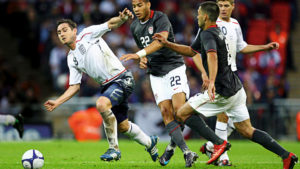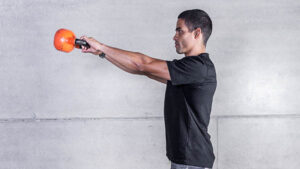
It’s football season, and time to start emulating your heroes’ success on the pitch. However, you should be aware of the injuries that players can incur as part of the game — especially if you don’t want to be left on the bench
We tackle football’s most prevalent injuries and discover how you can reduce the risk for an all-round better on-pitch performance.
Injured ankle
Harming the ankle is an unfortunately prevalent issue in this sport, due to the necessity of using your feet and legs. According to the CSP (Chartered Society of Physiotherapy), approximately 70-85% of these injuries are ‘inversion’ sprains, which means the ankle has been turned inwards — common when tackling and dribbling the ball. If you’re looking to reduce the risk of a sprained ankle, try and do these exercises three times a week:
- Shin raises (lifting your toes, rather than your heels, off the ground).
- Ankle circles (both clockwise and anti-clockwise).
- Calf raises.
Injured hamstring
Your hamstring is constantly at work during a footie match, so preparing this part of your legs for a game is essential if you want to avoid an injury. Found in the back of the leg, sometimes your hamstring muscles can overstretch, resulting in pain, as well as bruising and swelling. If you tear your hamstring, you could be out of action for a while, however, if you simply pull your hamstring, you should be fine to continue.
Currently have a back problem? If that’s the case, take extra care with regard to your hamstring. Reportedly, people with existing back issues are more susceptible to strained hamstrings, so loosen your back with exercises such as lumbar rotation stretches (lying on the floor and rolling your knees from side to side). Basic glute stretches will ease muscles around your hips, while yoga will help you stay flexible, which will lower the risk of hamstring strain. Squats, lunges and hamstring kicks are also great preventative exercises, as they work to strengthen the hamstring muscles.
According to many professionals, one of the top exercises to safeguard your hamstring is the Nordic ham curl:
- Kneel on the floor.
- Hook your feet under something sturdy and heavy that can take your weight or ask a partner to hold your feet to act as an anchor.
- Breathe deeply, engage your core and slowly lower yourself to the ground, using your hamstrings to keep your body straight.
- After reaching the ground, push yourself up and repeat.
Injured anterior cruciate ligament (ACL)
The ACL is found near the knee and has the job of helping to support it. However, it’s often damaged by the twisting and turning of the leg, which means it’s a common injury for football players. If you hurt your ACL, it’ll be painful and you’ll likely see swelling around the area. But before then, you may hear and feel it pop or snap…
Take the strain from your ACL and help to make it stronger by strengthening all your leg muscles. According to HSS, Hospital for Special Surgery, you should do plenty of leg stretches like squats and walking lunges. Having good balance — or proprioception — is vital if you want to avoid injuring your ACL too, so practice standing on one leg (30 seconds on each) regularly to boost your stability. These exercises also help prevent injuries to your menisci, which are cartilages that protect the knee joint.
Injured groin
You can probably name plenty of professional players who have missed important matches due to a groin injury. Unfortunately, it’s a common footie injury. If you strain your groin, you’ve basically over-extended your abductor muscles, found in your inner thigh. A slight strain will often cause some pain, however, serious groin strain injuries can impede on your ability to walk and run, which is a serious flaw for a football player.
Carrying out stretches and spending time warming-up your legs should help you dodge an injury to your groin area. Stretch your inner and outer thigh muscles daily and see if you can also get regular sports therapy or massage treatments to keep these muscles flexible. A strong core enhances pelvic stability, which will also reduce the chance of groin strains, so do plenty of planks and crunches as part of your basic workout routine. Resistance bands are also very handy for strengthening your inner thigh muscles and preventing groin strain.
The best way to get ready for a match
Football is the same as any sport: don’t warm-up first and you leave yourself open to injury. Warm-ups help blood reach your main muscles, which prepares them for the physical activity ahead.
Structured warm-ups are excellent for helping players avoid common football injuries and can reportedly even lower these by approximately 33% — according to a scientific study. Here’s a top warm-up session to help you prepare your tendons, ligaments and muscles for a good performance:
5 minutes: jogging and side-stepping to boost your core temperature.
15 minutes: stretching, focusing on your quads, glutes, hamstrings, inner thighs, lower back, calves, Achilles tendon, and hip flexors. You should hold your stretch for ten seconds every time.
10 minutes: mimicking football movements without a ball including high kicks, squats, jumps, and side-foot passes.
10 minutes: practicing shooting, heading, passing, and dribbling as a team with a football.
Have you also considered taking nutritional supplements to boost your on-pitch performance? Try vitamin D or C, which both have properties that can help your muscles, or give ubiquinol a go, which is a powerful antioxidant. Although, if you’re unsure which to go for, we suggest checking with a healthcare professional first.
Of course, a healthy diet is also key if you want to perform at your best. It’s recommended that you eat plenty of protein and carbohydrates — including eggs, whole-wheat pasta, brown rice, turkey and salmon — to build muscle and deliver energy. Also, lower your alcohol intake — it dehydrates you and leaves your muscles more susceptible to cramping and injury.
Boost your footballing skills and make sure you don’t miss a single training session or match in 2018 by following the above tips.
Sources:
https://www.ncbi.nlm.nih.gov/pmc/articles/PMC3497950/
http://www.csp.org.uk/your-health/sports-advice/physiotherapy-football-injuries
http://www.nsmi.org.uk/articles/football-injuries.html
https://www.ncbi.nlm.nih.gov/pmc/articles/PMC3289174/
http://www.coachmag.co.uk/sport/6832/how-to-prevent-and-treat-the-five-most-common-football-injuries
This move is king when it comes to core. Learn perfect form to reap maximum benefits and avoid injury.
The bounce back begins. There’s no doubt that the Covid-19 crisis curtailed fitness routines for millions, as competitions were cancelled, training programmes postponed and events put on […]



